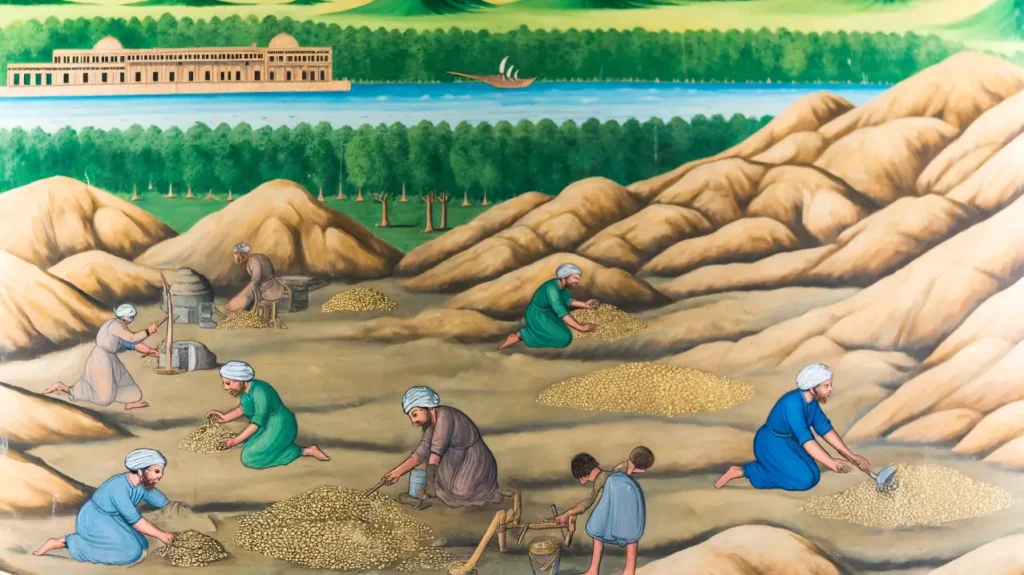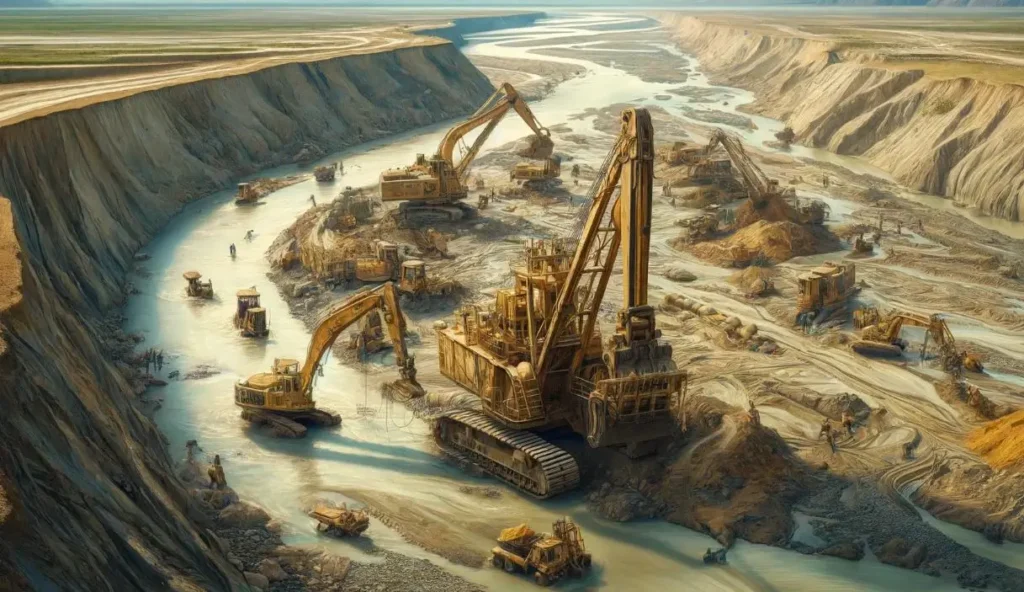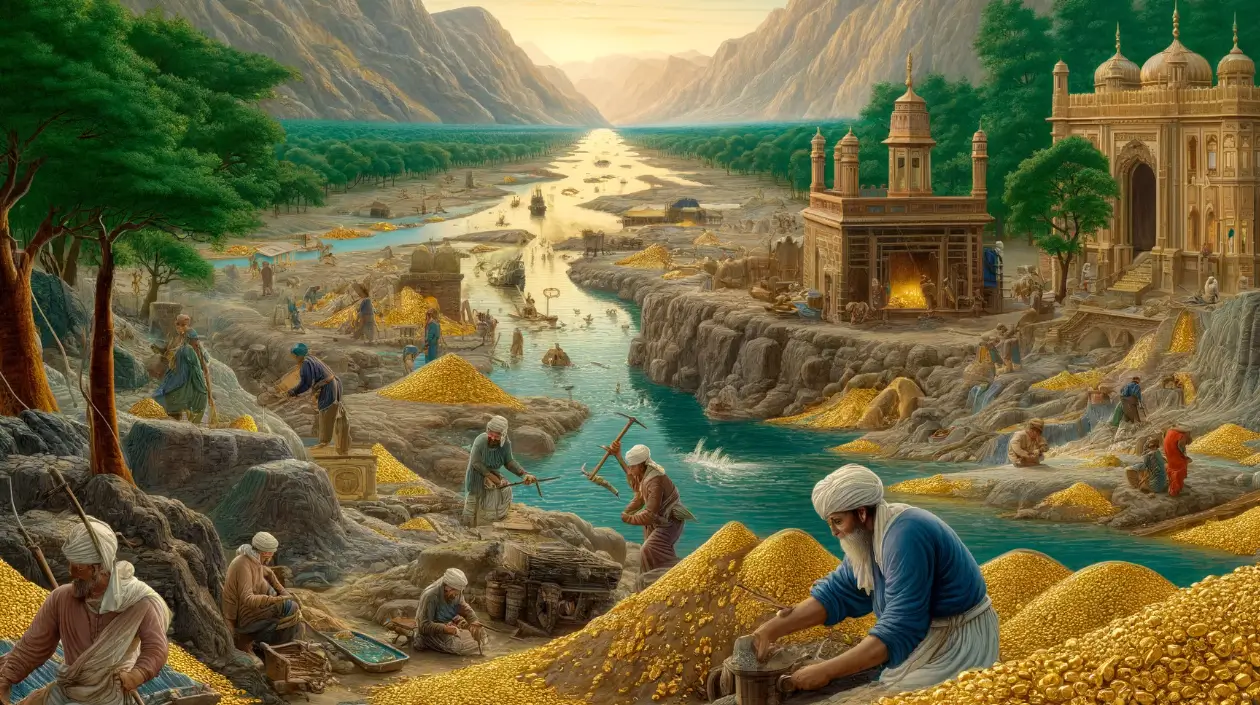Gold mining in the Indus Valley is a fascinating topic that contrasts sharply with modern techniques in metallurgy and mineral exploration programs.
Ancient miners used simple tools and methods, yet they managed to extract significant amounts of gold through unregulated mining and early mining engineering. This ancient civilization’s ingenuity and resourcefulness are evident in the Indus Valley Civilisation’s mining practices, including metallurgy and placer gold deposits utilized by the Indus people.
By exploring the history of gold mining in the Indus Valley, we gain insights into how early societies valued and utilized natural resources, including mineral exploration and ore management by the minerals department, ensuring security.
The techniques they developed laid the groundwork for future advancements in mining, mineral exploration, and placer gold deposits. Understanding these ancient methods not only highlights their achievements, such as those of the Indus Valley civilisation, but also offers lessons for today’s sustainable practices in areas like mineral exploration and ore management.
Key Takeaways about Gold Mining in the Indus Valley
- Ancient Gold Mining: The Indus Valley civilization had advanced methods for gold mining, showcasing their technical skills and economic strength.
- Environmental Concerns: Historical and modern gold mining activities have led to significant environmental degradation, including water pollution and habitat destruction.
- Illegal Mining: Unregulated mining operations continue to pose serious threats to both the environment and local communities, highlighting the need for stricter enforcement.
- Conservation Efforts: Various initiatives are in place to mitigate the negative impacts of gold mining, focusing on sustainable practices and rehabilitation of mined areas.
- Future Prospects: The future of gold mining in the Indus Valley region depends on balancing economic benefits with environmental protection and community welfare.
- Community Involvement: Engaging local communities in conservation efforts can lead to more effective and sustainable outcomes.
Gold Mining in the Indus Valley
Historical overview
Indus Valley people used simple methods for gold extraction. They panned for gold in the river and mined shallow deposits as part of mineral exploration. Panning involved using a shallow pan to separate gold from sand and gravel by washing it in water, a technique still used today.

Gold held great importance in the Indus Valley civilization. People used it for trade, making jewelry, and ceremonial objects, according to the minerals department. Gold beads and ornaments have been found in many archaeological sites, often linked to ore and mineral exploration monitored by the minerals department for security. These artifacts include intricately designed necklaces, bracelets, and earrings, showcasing the advanced craftsmanship of the Indus people.
Archaeologists have discovered evidence of early gold mining activities, including mineral exploration and ore extraction, along the Indus River. These findings show that Indus people valued gold highly.
Excavations have revealed ancient tools used for mining and processing gold, such as stone hammers and grinding stones. This indicates that the Indus Valley civilization had developed specialized techniques for extracting and refining gold from its natural sources.
Additionally, the presence of gold artifacts in burial sites suggests that gold had not only economic but also cultural significance. It was likely associated with social status and religious practices, reflecting its multifaceted role in Indus society.
The continuous discovery of new sites and artifacts further emphasizes the extensive nature of gold mining and its pivotal role in the daily life and economy of the Indus Valley civilization.
Modern techniques
Traditional panning has given way to heavy machinery for placer gold mining and mineral exploration. This shift allows miners to extract more gold quickly.
Technological advancements in mineral exploration have made illegal mining more efficient but also harmful to the environment. Miners now use techniques that damage riverbanks and ecosystems.
Modern illegal miners locate gold using metal detectors and other tools for mineral exploration and mining engineering. They dig deep into riverbeds, causing significant environmental repercussions. These actions lead to erosion and water pollution.
Key locations
Illegal gold mining and mineral exploration are most prevalent along specific areas of the Indus River due to the abundance of minerals. Nizampur in the Nowshera District is a key location.
These areas are strategically important for miners due to their accessibility and rich gold deposits, making them ideal for mineral exploration and mining engineering. The scenic Indus River provides easy access to these mineral deposits, facilitating mining engineering.
Historical sites within these key locations are affected by minerals and mining activities. The disruption harms both the environment and cultural heritage.
Environmental Impact
Water risks
Mining operations in the Indus Valley often divert river water for minerals. This affects local water supplies. Communities downstream rely on the Indus River for drinking water, agriculture, minerals, and mining engineering. When mining diverts water, these communities face shortages.
Sedimentation and turbidity increase due to mining. Sediments make the water cloudy. This reduces water quality. Fish and other aquatic life struggle to survive in such conditions.
Downstream communities experience severe consequences. They depend on the river for their crops and daily needs. Water quality degradation impacts their health and livelihoods.
Biodiversity threats
Gold mining destroys habitats along the Indus River. Many species lose their homes. Some of these species are endangered. For example, the Indus River Dolphin faces habitat loss due to mining activities.
Aquatic ecosystems suffer disruption. When miners disturb the riverbed, it affects fish populations. Birds that feed on these fish also face threats. The entire food chain gets disrupted.
Turtle breeding grounds along the Indus River are at risk too. Mining activities destroy these crucial areas. As a result, turtle populations decline.
Pollution concerns
Illegal mining operations release various pollutants into the river. These include heavy metals like mercury and arsenic. Chemical runoff from mining sites also pollutes the water.
Such pollutants pose long-term environmental health risks. Wildlife suffers from contaminated water sources. Humans who consume this water face serious health issues too.
Specific incidents highlight the severity of pollution from illegal mining. In some areas, fish kills have been reported due to toxic runoffs. Heavy metal contamination from mining engineering has led to unsafe drinking water levels for local populations.
Illegal Mining Activities
Threats to the river
Illegal mining operations have severely altered the Indus River. Heavy machinery used in illicit placer gold mining activities has damaged the riverbed and banks. This leads to erosion and loss of natural habitats.
The alterations disrupt the natural flow of the river. It affects flood patterns, making some areas prone to flooding while others face water shortages. The changes also impact water availability for agriculture and drinking.

Efforts to monitor these threats are minimal. There are few initiatives to mitigate the damage. Local authorities lack resources and face challenges in controlling illegal activities.
Impact on wildlife
Wildlife in the Indus Valley suffers due to illegal gold mining. Specific examples include fish dying from polluted waters and birds losing nesting sites. The use of heavy machinery destroys habitats crucial for many species.
Reduced biodiversity is a significant concern. Less variety in species weakens the entire ecosystem. It makes the environment more vulnerable to further damage.
Conservation efforts are limited but exist. Some local groups attempt to protect affected wildlife. They struggle against ongoing exploitation and lack of support from larger organizations.
Legal framework
Laws governing gold mining in the Indus Valley exist but are often ineffective. Regulations aim to control both legal and illegal mining activities. Despite this, enforcement remains a major issue.
Challenges in enforcing laws include corruption among officials and insufficient resources. Powerful mafia groups involved in illegal gold mining operations often evade prosecution. Violators rarely face significant penalties.
Recent proposals seek to strengthen the legal framework. These include stricter penalties for illegal mining and better funding for enforcement agencies. However, progress is slow, and ongoing exploitation continues.
Conservation Efforts
Government initiatives
Governments have taken steps to curb illegal gold mining in the Indus Valley. They conduct raids and impose fines on those caught mining illegally. Authorities also confiscate machinery used in these activities.
Local and national government bodies regulate mining activities. They protect the environment through strict laws and regulations. Officials often make public statements about their commitment to fighting illegal mining.
Community actions
Local communities play a significant role in protecting their environment. They organize protests against illegal mining operations. These actions aim to safeguard their land and water resources.
|
Community Action |
Purpose |
Impact |
|---|---|---|
|
Protests |
Oppose illegal mining operations |
Protects land and water resources |
|
Cleanup Drives |
Remove litter and pollutants from areas |
Improves local environment quality |
|
Tree Planting Initiatives |
Increase green cover |
Enhances air quality and biodiversity |
|
Educational Workshops |
Raise awareness about environmental issues |
Empowers community with knowledge |
|
Recycling Programs |
Promote waste segregation and recycling |
Reduces landfill waste and pollution |
|
Water Conservation Projects |
Implement water-saving techniques |
Ensures sustainable water use |
|
Community Gardens |
Grow local produce sustainably |
Provides fresh food and fosters community |
|
Wildlife Protection Efforts |
Protect local wildlife and habitats |
Preserves biodiversity |
Community-led conservation projects are also common. Some communities have successfully mobilized to stop or reduce illegal mining. These efforts help preserve their valuable resources and livelihoods.
International support
International agreements and partnerships address the issues of illegal gold mining in the Indus Valley. Global conservation organizations provide support and resources for these efforts. They help local authorities combat illegal activities.
Specific international projects focus on river conservation and sustainable mining practices. These projects aim to balance environmental preservation with economic needs. By working together, they strive to protect the Indus Valley’s natural resources.
Future Prospects
Placer gold evaluation
Evaluating placer gold deposits involves several steps. Experts assess the potential yields by sampling river sediments. They look for fine particles of gold mixed with sand and gravel. This process helps estimate how much gold can be extracted.
Environmental impacts are also considered. Mining activities can disrupt ecosystems and water quality. Evaluators check for these risks before any mining starts.
Economic viability depends on many factors. Legal operations must follow strict rules, which can be costly. Illegal mining is cheaper but causes more environmental damage. Studies show that both types of operations exist in the Indus Valley.
Reports estimate that thousands of grams of gold are extracted from the Indus River each year. These figures highlight the ongoing interest in this resource.
New mining projects
Several new legal mining projects have been proposed in the Indus Valley. These projects aim to boost the local economy by creating jobs and generating revenue. However, they also raise concerns about environmental damage.
New projects must meet strict criteria to gain approval. Regulations focus on sustainability and conservation. Projects need to show plans for minimizing environmental impact and rehabilitating damaged areas.
Local communities and environmental groups often have mixed reactions. Some support new projects for their economic benefits. Others oppose them due to potential harm to the environment and local wildlife.
Sustainable practices
Sustainable gold mining practices are crucial for minimizing environmental impact. Techniques like using less water and avoiding harmful chemicals can make a big difference. Replanting trees and restoring land after mining helps too.
Rehabilitating areas damaged by illegal mining is possible but challenging. Efforts include cleaning up polluted water and reintroducing native plants and animals. Successful rehabilitation can restore ecosystems and improve water quality.
Examples from other regions show that sustainable practices work. In some places, miners use eco-friendly methods to extract gold without harming the environment. These examples can serve as models for the Indus Valley.
For an overview about the Ancient Gold Mining Techniques and History, please check this guide.
Closing Thoughts
Gold mining in the Indus Valley is a complex issue with significant environmental and social impacts. Illegal activities and conservation efforts shape the current landscape, while future prospects remain uncertain. Your awareness and involvement can make a difference.
Take action now.
Educate yourselves, support sustainable practices, and advocate for stricter regulations. Together, you can help preserve this historic region and ensure a brighter future for its communities.
Frequently Asked Questions about Gold Mining in the Indus Valley
What is the history of gold mining in the Indus Valley?
Gold mining in the Indus Valley dates back to ancient times. Evidence suggests that early civilizations engaged in gold extraction and trade, contributing to their wealth and development.
How does gold mining impact the environment in the Indus Valley?
Gold mining can lead to deforestation, soil erosion, and water contamination. These activities disrupt local ecosystems and harm wildlife.
Are there any illegal gold mining activities in the Indus Valley?
Yes, illegal mining is a significant issue. It often leads to unregulated environmental damage and poses risks to miners’ safety.
What are the conservation efforts for gold mining in the Indus Valley?
Conservation efforts include stricter regulations, sustainable mining practices, and community education programs. These initiatives aim to protect natural resources and promote responsible mining.
What are the future prospects for gold mining in the Indus Valley?
The future of gold mining depends on balancing economic benefits with environmental protection. Sustainable practices and advanced technologies could shape the industry’s future positively.
How does illegal gold mining affect local communities?
Illegal gold mining can lead to health hazards, loss of livelihoods, and social conflicts. It often deprives communities of fair economic benefits.
What role do governments play in regulating gold mining in the Indus Valley?
Governments enforce laws, monitor activities, and promote sustainable practices. They aim to ensure that mining operations benefit both the economy and the environment.








